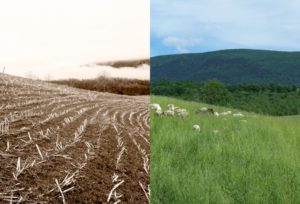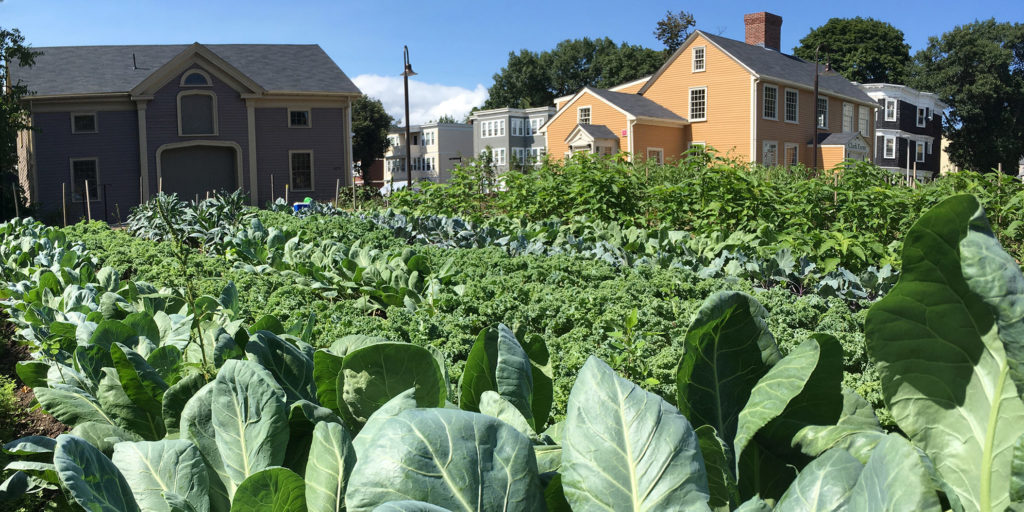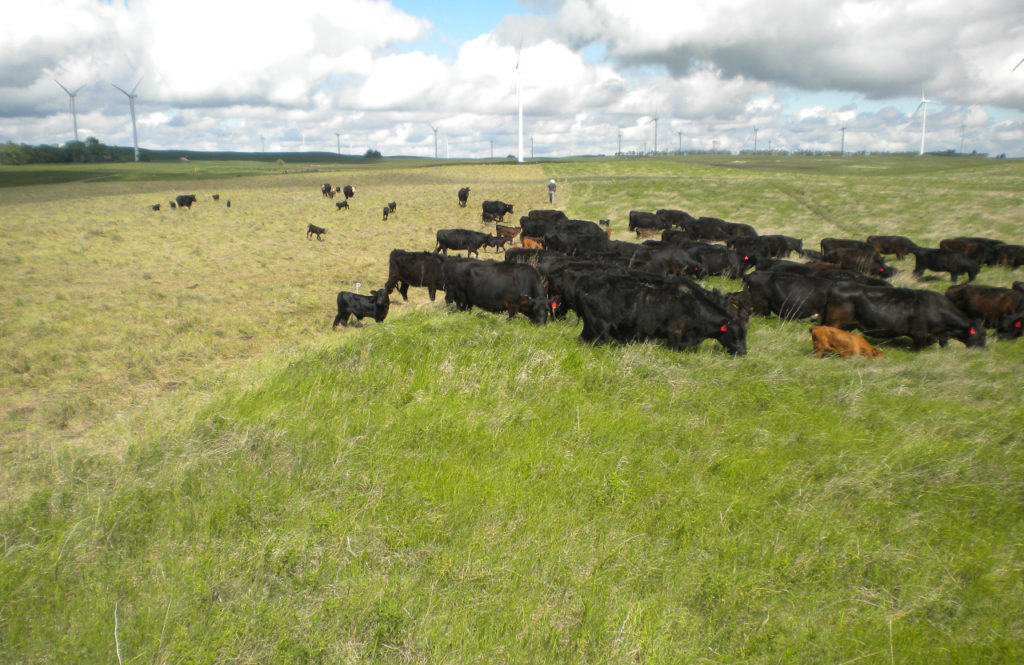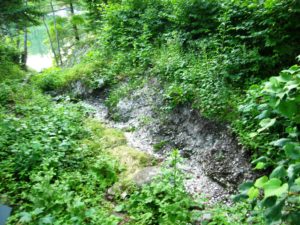Regrounding Regenerative Agriculture
Photo: Fowler Clark Epstein Urban Farm, Regenerative Design Group 2018
For decades, organic farming was considered the pinnacle of environmentally friendly agriculture. Now, another movement is gaining traction, one which goes a step beyond simply eliminating certain harmful chemicals or improving the living conditions of livestock. Regenerative agriculture sharply diverges from conventional agricultural methods, incorporating practices such as low or no-till planting, rotating crops, planting cover crops, livestock grazing, and applying compost and manure. By aiming to not merely avoid harming the environment, but in fact actively combat global climate change, regenerative agriculture takes a holistic approach that views a farm’s ecosystem in its entirety with the objective of improving and restoring the health of the soil.[1]
The agricultural methods encompassed within regenerative agriculture provide cultivated land with a wide variety of benefits, fostering healthy soil microbiomes, promoting plant growth, improving the biodiversity of insects and plants in the soil, and increasing the amount of nutrients available to growing crops. Reducing or eliminating tilling has the additional benefits of making soil more resistant to erosion, as well as preventing the release of large quantities of carbon into the atmosphere.[2]
Increased carbon sequestration is perhaps the most environmentally significant benefit of regenerative agriculture. Carbon is continually entering soil through the decay of organic matter, and is absorbed from both soil and air by plants during photosynthesis, a process in which energy from sunlight transforms carbon dioxide and water into organic compounds that nourish plants. Though oceans hold the majority of Earth’s carbon, there are currently more than 2500 billion tons of carbon sequestered in the planet’s soil––more than three times the amount in the atmosphere. However, conventional farming methods have released 50 to 70% of the carbon from agricultural soils, and much of that released carbon has bonded with atmospheric oxygen to form carbon dioxide, a harmful greenhouse gas. While this trend is alarming, it also indicates a promising opportunity to remove large quantities of carbon from the atmosphere––by returning it to the soil, and transforming the planet’s agricultural lands from major greenhouse gas emitters into massive carbon sinks. By preventing large quantities of carbon from escaping into the atmosphere and helping to return atmospheric carbon to the soil, regenerative farming practices have the potential to help combat global climate change.[3]

Jessie Farm side by side comparison before and after holistic grazing. The crucial role of holistic grazing to regenerate soils and store carbon. Courtesy of Soil4Climate
Growing awareness of the importance of soil health––and the potential of healthy soil to mitigate climate change––has led to the introduction of dozens of state-level bills across the United States, many of which have been passed into law. In January of 2021, Massachusetts became the latest state to prioritize regenerative agriculture with the passage of the Healthy Soils Amendment. The law provides funding for the creation of a program to incentivize land managers and farmers to engage in healthy soil practices. Among its provisions are educational and technological resources for those interested in adopting these practices, and financial incentives to encourage them to do so.[4]
Curiously absent from many discussions of regenerative agricultural methods is remineralization, the practice of applying mineral-rich rock dust to soil. Volcanic materials, glacial sediments, granite, and phosphorite are especially apt for remineralizing due to their high mineral levels. Studies have demonstrated that remineralization has many of the same positive effects as other regenerative strategies, including reducing erosion and improving soil microbiomes. It improves plants’ ability to take in nutrients, which fortifies them against disease, pests, drought and frost. Livestock that consume plants grown in remineralized soil also experience health benefits.[5]
Prioritizing remineralization seems like an obvious choice for practitioners of regenerative agriculture, as it would improve soil’s fertility and resilience, as well as the quality of the crops grown in it. Indeed, soil remineralization is beginning to gain traction in various regions around the world. Brazil, Mexico, Colombia, and Cameroon are among the countries that have developed programs in which rock dust is applied to crops and other lands, which have yielded positive results ranging from improved water retention to higher nutrient levels to larger crop yields.[6]
The potential benefits of regenerative agriculture are exciting, so it’s no surprise that it’s gaining prominence in discussions of how agriculture can be adapted on a large scale to mitigate the effects of climate change. These discussions, however, often present regenerative agriculture as a nascent practice, one that emerged within the last half-century to address the pressing environmental issues of the modern day. In reality, the rise of regenerative agriculture has been less a process of discovery and more one of re-discovery, as many of the practices encompassed within the movement have been used by Indigenous peoples worldwide for thousands of years. In fact, though soil remineralization has yet to gain widespread recognition even within the regenerative agriculture movement, evidence suggests it was practiced by Indigenous people residing in the Redwood forests of what is now California for thousands of years. Mounds containing fragmented bones, shells, and stones found throughout these forests were long dismissed as refuse middens, but careful study of their size, construction methods, and constituent materials has led some scientists to believe they were created for the deliberate purpose of enriching forest ecosystems with minerals.[7]
The practice of soil remineralization in the Redwoods is just one of countless examples of how Indigenous land management practices have been downplayed and erased from the historical narrative. When Europeans arrived in the Americas, they created a false binary between their agricultural system and the land management practices of Indigenous peoples, privileging their own methods as the only “real” agriculture. Only in recent decades has the role of Indigenous peoples in cultivating the land they lived on begun gaining widespread awareness and appreciation.[8]
Just as organic products became popular in response to growing environmental consciousness among consumers, regenerative agriculture has the potential to cultivate a new paradigm, one in which consumers seek out foods grown in ways that not only avoid causing undue environmental harm but also actively improve the health of the environment. This is a shift in the right direction, but it’s not enough to view the benefits of this practice on the level of individual metrics, such as the quantity of nutrients or the amount of sequestered carbon in a given farm’s soil.
The harmful agricultural practices that contributed to the current climate crisis are just one symptom of a broader colonial mindset that has long viewed both natural resources and Indigenous peoples as exploitable. Thus, any movements to make agriculture sustainable must be informed by principles of environmental justice, not only countering harm caused to lands, but harm caused to the people who have historically resided on them. By centering Indigenous individuals and perspectives and incorporating the vast environmental knowledge and resilience held by Indigenous communities, agriculture can approach being truly regenerative.[9]
Pavi Chance is a contributing science writer for Remineralize the Earth, and a recent graduate of Barnard College with a degree in English and human rights studies. Growing up in the beautiful Pacific Northwest, she developed an enduring appreciation for the natural world, and seeks to ensure it is protected and preserved for generations to come.
For more information on how climate change affects the ocean, see this post at Sofar Ocean.
References
[1, 2] Regenerative Agriculture Initiative, & The Carbon Underground. (2017, February 24). What is regenerative agriculture? Regeneration International. https://regenerationinternational.org/2017/02/24/what-is-regenerative-agriculture/
[3] Schwartz, J. D. (2014, March 4). Soil as carbon storehouse: New weapon in climate fight? Yale Environment 360. https://e360.yale.edu/features/soil_as_carbon_storehouse_new_weapon_in_climate_fight
[4] New state program to build healthy soils, climate resilience. (2021, April 2). NOFA/Mass.https://www.nofamass.org/articles/2021/02/new-state-program-to-build-healthy-soils-climate-resilience/
[5] A Rock Dust Primer. (n.d.). Remineralize the Earth. https://www.remineralize.org/wp-content/uploads/2020/08/A-Rock-Dust-Primer-08_02_20.pdf
[6] Campe, J. (2014). Potential of remineralization as a global movement. Geotherapy, 81-110. https://doi.org/10.1201/b13788-5
[7] Klinger, L (2006) “Ecological Evidence of Large-scale Silviculture by California Indians,” in Unlearning the Language of Conquest: Scholars Expose Anti-Indianism in America, ed. DT Jacobs, University of Texas Press (Austin), pp. 153-165
[8] Briones, A. R. (2020, October 13). Regeneration—from the beginning. Nonprofit Quarterly. https://nonprofitquarterly.org/regeneration-from-the-beginning/
Support us on Patreon
Thank you for joining us today! Please become a member of RTE and support us on Patreon. Unlike many larger organizations, we work with a team of determined and passionate volunteers to get our message out. We aim to continue to increase the awareness of remineralization to initiate projects across the globe that remineralize soils, grow nutrient dense food, regenerate our forests’ and stabilize the climate – with your help! If you can, please support us on a monthly basis from just $2, rest assured that you are making a big impact every single month in support of our mission. Thank you!











Got something to say?